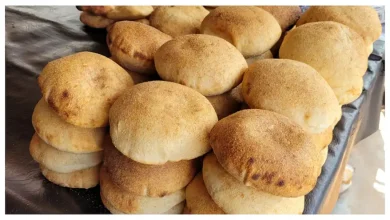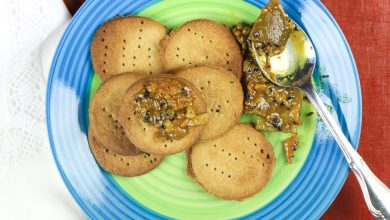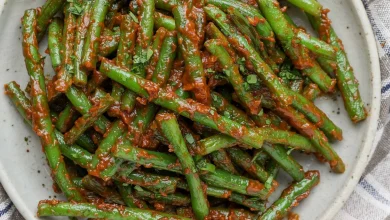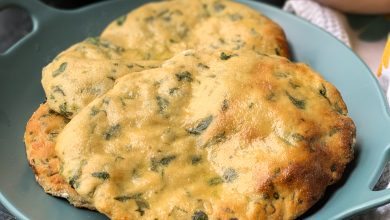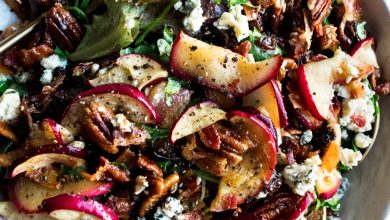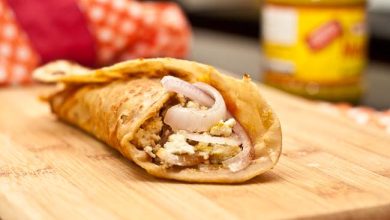Quick & Easy Homemade Puff Pastry Sheets for Puffs, Tarts & Pies
Homemade Quick Puff Pastry Sheets: Perfect for Puffs, Tarts & Pies
Puff pastry is the epitome of light, flaky, and buttery goodness that elevates any dish, whether you’re making delicate pastries, savory tarts, or indulgent pies. If you’ve ever wondered how to create this crispy, golden magic at home, this quick puff pastry recipe is just what you need. After several trials and experiments, we’ve created a simple yet effective method using ingredients you likely already have in your kitchen. Get ready to experience the joy of making your very own puff pastry—perfect for all your culinary creations.
Ingredients
| Ingredient | Quantity |
|---|---|
| All Purpose Flour (Maida) | 330 grams (plus extra for dusting) |
| Caster Sugar | 2 teaspoons |
| Salt | 1.5 teaspoons |
| Butter (Salted), chilled and chopped | 340 grams (into 3/4 inch cubes) |
| Chilled Water | 120 ml (approx, adjust as needed) |
Preparation Time
- Total Time: 24 hours (including resting time)
- Preparation Time: 40 minutes
- Chilling Time: 2–24 hours
- Cook Time: 0 minutes (this is a prep-only recipe)
Instructions
Step 1: Prepare the Dough
To begin making this delicious homemade puff pastry, gather all your ingredients and ensure they are ready to go. Start by adding the flour and salt to a large mixing bowl. Stir them together briefly to combine. Next, add the chilled butter cubes into the flour mixture. Your goal here is to coat each butter cube in flour to prevent the butter from melting into the dough prematurely. This process, known as lamination, is key to achieving that signature flaky texture in your puff pastry.
Once the butter is well-coated, squish each cube of butter between your fingers. This is a crucial step—press the butter so it flattens and forms small, irregular pieces. You should see visible chunks of butter throughout the dough, which will create those glorious layers when baked. After squishing the butter, toss it all back in the flour to ensure it’s well-coated again.
Step 2: Add the Water
Make a well in the center of your flour-butter mixture and begin adding chilled water slowly, about a tablespoon at a time. Mix it gently with your hands to incorporate the flour into the water without kneading. Do not knead the dough; this is critical to avoid activating the gluten, which would make the pastry tough.
Once the mixture begins to come together into large clumps, gently knead it just enough to understand whether it needs more water. You want a dough that holds together without being too sticky. If it becomes too wet, it will be hard to handle, so be mindful. The dough should look rough and rustic, with chunks of butter still visible.
Step 3: First Folds and Resting
Divide the dough into two equal portions and shape them into flat discs. Roll each disc into a rectangle that’s about 1 inch thick, approximately 5×8 inches in size. Fold the dough in thirds like a letter—fold the bottom third over, then fold the top third down. This is your first fold.
Next, wrap each disc of dough in plastic wrap and refrigerate it for at least 2 hours, though you can leave it for up to 24 hours if you wish. This resting period allows the dough to relax and the butter to re-solidify, both of which are important for achieving the delicate layers later.
Step 4: Roll, Fold, and Chill Again
After your dough has chilled for the initial period, remove one disc from the fridge. Lightly flour your work surface and roll the dough into a rough rectangle about ½ inch thick. If the dough feels too tough or sticky, let it rest for 5 minutes to make it easier to work with.
Once you’ve rolled out the dough, perform the same folding process—fold it in half, then fold it again into quarters. Dust with flour as needed to prevent sticking, and continue rolling it out into a ½ inch thick rectangle. Repeat this fold-and-roll process for at least 5 more rounds. This is where the magic of puff pastry happens—each fold creates layers of butter and dough that will puff up beautifully when baked.
Once the final fold is complete, wrap the dough back in plastic wrap and refrigerate it again for 1 hour. This will ensure the dough firms up and is ready for the next phase.
Step 5: Final Rolling and Resting
After the second chilling period, take the dough out again and roll it out into a larger rectangle. At this point, your dough should be soft and pliable but still layered with cold butter. You can now use it as needed for your recipes. Whether you’re making puff pastry puffs, tarts, or pies, the dough is ready for action.
Step 6: Storage Options
If you don’t plan to use the puff pastry immediately, you can store it for later use. Wrap the dough tightly in plastic wrap and place it in an airtight container or resealable bag. You can keep it in the refrigerator for up to 2 days, or freeze it for up to 3-4 months. When you’re ready to use it, simply let it thaw at room temperature for 15-20 minutes before rolling out and using.
Tips for Success:
- Keep Everything Cold: Ensure that both the butter and water are chilled before using them. The colder the butter, the flakier your pastry will be.
- Work Quickly: Puff pastry dough should be handled as little as possible to avoid melting the butter. The faster you work, the more successful your pastry will be.
- Don’t Skip the Resting: Resting is crucial to getting the dough to the right consistency. Patience is key to perfect puff pastry!
- Flour Sparingly: Be careful not to add too much extra flour when rolling out the dough. Too much flour will affect the texture of the pastry.
Serving Suggestions:
Use your homemade puff pastry sheets to create a wide variety of dishes. Here are some ideas:
- Puff Pastry Puffs: Stuff with sweet or savory fillings, such as chocolate or cheese, and bake until golden and puffy.
- Tarts: Use the dough to line tart pans and fill with your favorite custards, fruits, or savory fillings.
- Pies: Top any of your favorite pies with a buttery, flaky layer of homemade puff pastry.
- Vol-au-Vents: Create small, puffed cases to be filled with creamy sauces or seafood.
Conclusion:
This homemade quick puff pastry recipe proves that with just a few simple ingredients—flour, butter, and water—you can create a flaky, buttery pastry that will elevate any dish. Though it requires patience and a little technique, the result is well worth the effort. Perfect for everything from savory puffs to sweet pies, your homemade puff pastry will be a go-to in your kitchen for years to come. So, next time you’re craving something light, crispy, and delicious, remember—you can make it all from scratch, right at home!

